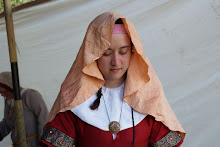 One of my major gripes is that many people tend to think of the Byzantine empire as only being Greece, Egypt, and part of Asia Minor. I find that the most interesting artwork, however, comes from the fringes, and is a unique combination of regional and traditional Byzantine style. The further away from Constantinople you go, the more regional the art gets. In my opinion, The Sudan (Nubia) and Ethiopia belong to those ignored areas of Byzantine art. Although they, like Russia, were never part of the Empire, they both were christianized by the Byzantines (Nubia in the mid 6th century and Ethiopia in the mid 4th) and, as a result, their cultures and artwork were very much influenced by this. Here are two examples of Nubian frescos, these two both come from Faras.
One of my major gripes is that many people tend to think of the Byzantine empire as only being Greece, Egypt, and part of Asia Minor. I find that the most interesting artwork, however, comes from the fringes, and is a unique combination of regional and traditional Byzantine style. The further away from Constantinople you go, the more regional the art gets. In my opinion, The Sudan (Nubia) and Ethiopia belong to those ignored areas of Byzantine art. Although they, like Russia, were never part of the Empire, they both were christianized by the Byzantines (Nubia in the mid 6th century and Ethiopia in the mid 4th) and, as a result, their cultures and artwork were very much influenced by this. Here are two examples of Nubian frescos, these two both come from Faras.The first one depicts Queen Martha, protected by the Virgin Mary and a martyred soldier, and dates from the 11th century. Martha's dress is a beautiful mix of traditional style and Byzantine ceremonial garb.
 The second image shows a Nubian princess being protected by the Virgin Mary, and dates from the 12th century.
The second image shows a Nubian princess being protected by the Virgin Mary, and dates from the 12th century.Both are in the National Museum at Khartoum.
The next image comes from an Ethiopian illumination, dating before 1350. It is a depiction of the angels leading Mary to Temple. It comes from the Cloister Estifanos at
Lake Hayq.

In this illumination, you can really see the mix of Byzantine themes and style, with very Ethiopian elements. What is especially typical of the region are the noseless, mouthless faces and the oversized eyes. What I love about it is the beauty that lies in its simplicity.
It is now located in the National Library at Addis Ababa, Inventory number A.5
Source: Volbach, W.F., J. Lafontaine-Dosogne. "Propyläen Kunst Geschichte, Band 3: Byzanz". Propyläen Verlag, Berlin.

No comments:
Post a Comment